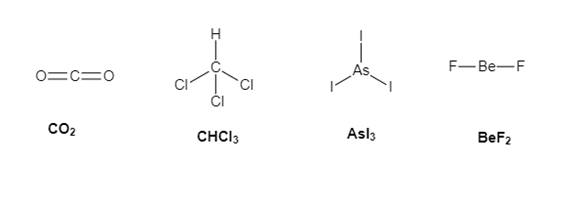
Concept explainers
Interpretation:
The compound that contains at least one pi bond is to be predicted.
Concept introduction:
In the molecular formula, the element symbols and the subscripts number tells the type and the number of each atom in a molecule.
There are so many methods to represent a molecule. In ball-and-stick method, the atoms of each element are depicted by ball and the bond is depicted by stick. In structural formula method, the atoms of each element are depicted by letter symbols and bond is used to show relative position.
Answer to Problem 2STP
The compound that contains pi bond is
Explanation of Solution
Reason for correct option: The given compound is

It is known that in single bond only sigma bond is present. In double bond, one bond is sigma and one is pi bond. In triple bond, one bond is sigma and the remaining two bonds are pi bond.
The representation of sigma and pi bonds in given compound (

Therefore, only
Reason for incorrect option: The
The
The
Chapter 8 Solutions
Chemistry: Matter and Change
Additional Science Textbook Solutions
Chemistry: Structure and Properties
Chemistry: A Molecular Approach (4th Edition)
Organic Chemistry
Introductory Chemistry (6th Edition)
Chemistry: The Central Science (14th Edition)
General Chemistry: Principles and Modern Applications (11th Edition)
 ChemistryChemistryISBN:9781305957404Author:Steven S. Zumdahl, Susan A. Zumdahl, Donald J. DeCostePublisher:Cengage Learning
ChemistryChemistryISBN:9781305957404Author:Steven S. Zumdahl, Susan A. Zumdahl, Donald J. DeCostePublisher:Cengage Learning ChemistryChemistryISBN:9781259911156Author:Raymond Chang Dr., Jason Overby ProfessorPublisher:McGraw-Hill Education
ChemistryChemistryISBN:9781259911156Author:Raymond Chang Dr., Jason Overby ProfessorPublisher:McGraw-Hill Education Principles of Instrumental AnalysisChemistryISBN:9781305577213Author:Douglas A. Skoog, F. James Holler, Stanley R. CrouchPublisher:Cengage Learning
Principles of Instrumental AnalysisChemistryISBN:9781305577213Author:Douglas A. Skoog, F. James Holler, Stanley R. CrouchPublisher:Cengage Learning Organic ChemistryChemistryISBN:9780078021558Author:Janice Gorzynski Smith Dr.Publisher:McGraw-Hill Education
Organic ChemistryChemistryISBN:9780078021558Author:Janice Gorzynski Smith Dr.Publisher:McGraw-Hill Education Chemistry: Principles and ReactionsChemistryISBN:9781305079373Author:William L. Masterton, Cecile N. HurleyPublisher:Cengage Learning
Chemistry: Principles and ReactionsChemistryISBN:9781305079373Author:William L. Masterton, Cecile N. HurleyPublisher:Cengage Learning Elementary Principles of Chemical Processes, Bind...ChemistryISBN:9781118431221Author:Richard M. Felder, Ronald W. Rousseau, Lisa G. BullardPublisher:WILEY
Elementary Principles of Chemical Processes, Bind...ChemistryISBN:9781118431221Author:Richard M. Felder, Ronald W. Rousseau, Lisa G. BullardPublisher:WILEY





